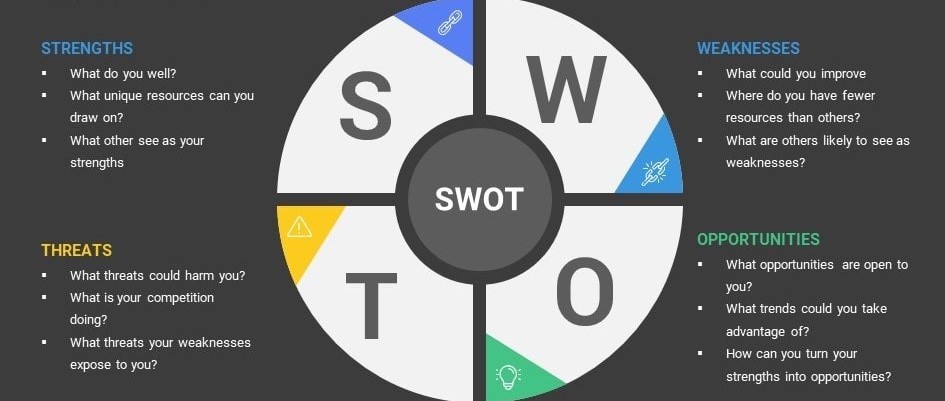Why the need to do a SWOT Analysis?

A SWOT analysis is a strategic planning technique that identifies and analyzes an organization’s strengths, weaknesses, opportunities, and threats. It can help you make smart, informed business decisions by providing a comprehensive overview of your company’s position within your market or industry.
A SWOT analysis can be used for a variety of purposes, including:
- Strategic planning: A SWOT analysis can help you develop a strategic plan for your business by identifying your strengths and weaknesses and the opportunities and threats in your market.
- Marketing: A SWOT analysis can help you develop marketing strategies that capitalize on your strengths and opportunities and mitigate your weaknesses and threats.
- Operations: A SWOT analysis can help you improve your operations by identifying areas where you can improve efficiency, reduce costs, or increase quality.
- Human resources: A SWOT analysis can help you develop human resources strategies that attract and retain top talent and build a strong company culture.
No matter what your purpose, a SWOT analysis can be a valuable tool for improving your business. Here are some of the benefits of doing a SWOT analysis:
- Improved decision-making: A SWOT analysis can help you make more informed decisions by providing you with a comprehensive overview of your company’s situation.
- Increased focus: A SWOT analysis can help you focus your efforts on your strengths and opportunities and avoid wasting time and resources on your weaknesses and threats.
- Improved communication: A SWOT analysis can help you communicate your company’s strategy to employees, customers, and partners.
- Increased innovation: A SWOT analysis can help you identify new opportunities for growth and innovation.
A SWOT analysis is a great place to start if you’re looking for a way to improve your business. It’s a simple yet powerful tool that can help you make smarter decisions, improve your focus, and increase your chances of success.
Here are some tips for conducting a SWOT analysis:
- Be thorough: When identifying your strengths, weaknesses, opportunities, and threats, be as thorough as possible. Don’t be afraid to ask for input from your employees, customers, and partners.
- Be objective: When evaluating your strengths and weaknesses, try to be as objective as possible. Don’t let your personal biases cloud your judgment.
- Be realistic: When identifying opportunities and threats, be realistic about your company’s ability to capitalize on them or mitigate them.
- Use the results: Once you’ve completed your SWOT analysis, use the results to develop a strategic plan for your business.
Examples of Real-life Applications of SWOT
Example 1: Handmade Organic Soap Shop
-
Strengths (internal, positive factors):
- Unique product: handmade and organic soaps are a niche that appeals to environmentally-conscious and health-conscious consumers.
- High-quality ingredients: sourcing organic, high-quality ingredients can lead to a superior product.
- Strong relationship with local suppliers: this can ensure a steady flow of necessary ingredients and materials.
-
Weaknesses (internal, negative factors):
- Limited production capacity: as a small business, there might be limits to how much soap can be produced at a time.
- Higher price point: the cost of organic, high-quality ingredients might necessitate a higher selling price, which could deter some customers.
- Limited distribution channels: the business might currently only sell in local markets and online, which limits potential customers.
-
Opportunities (external, positive factors):
- Growing interest in organic and eco-friendly products: consumers are becoming more interested in organic, sustainable products, which could increase demand for the soaps.
- Potential for partnerships: the business could partner with local shops or wellness centers to sell their soaps, expanding their distribution.
- Online marketplaces: platforms like Etsy or Amazon could provide a larger customer base.
-
Threats (external, negative factors):
- Competition: there are likely many other small businesses, as well as large corporations, that sell similar products.
- Changes in supplier prices: as the business relies on a few local suppliers, any changes in their pricing could impact the cost of production.
- Regulatory changes: laws and regulations around organic labeling or selling handmade goods could impact the business.
Based on this SWOT analysis, the business owner might decide to invest more in marketing to promote their unique, high-quality soaps and educate potential customers about the benefits of organic, handmade products. They could also explore new partnerships or online marketplaces to expand their distribution. At the same time, they would need to keep an eye on supplier prices and any regulatory changes that could impact their business.
Example 2: Small Coffee Shop:
-
Strengths (internal, positive factors):
- Well-trained staff who are able to provide high-quality customer service.
- High-quality, locally sourced coffee beans which make the taste of the coffee stand out.
- A comfortable, well-decorated environment that encourages customers to stay and enjoy their visit.
-
Weaknesses (internal, negative factors):
- Limited financial resources to expand or increase inventory.
- Limited opening hours, not being open in the early morning or late evening when potential customers may want coffee.
- A location that is not easily accessible, requiring a long walk from the nearest public transportation.
-
Opportunities (external, positive factors):
- There is an increasing trend in the city of consumers preferring local and organic produce, which the coffee shop could cater to.
- Partnership opportunities with other local businesses (like bakeries or bookstores) could increase exposure and customer base.
- The city is planning to develop the area around the shop, which could bring in more potential customers.
-
Threats (external, negative factors):
- There are several well-known, international coffee chains with a strong presence in the city which could be a strong competition.
- Increases in rent in the area may put financial strain on the coffee shop.
- The current global economic instability makes it uncertain whether people will continue to spend money on non-essential items like specialty coffee.
By completing this SWOT analysis, the coffee shop owner can start to create a strategic plan that plays to their strengths, mitigates their weaknesses, capitalizes on opportunities, and minimizes the impact of threats. For example, they might decide to expand their opening hours to attract more customers and try to negotiate a long-term lease to avoid potential rent increases. They could also look at partnerships with local bakeries or bookstores to increase their exposure and capitalize on the trend towards local produce.
Conclusion
SWOT analysis is a strategic planning tool that can help businesses identify their strengths, weaknesses, opportunities, and threats. By understanding these four factors, businesses can develop a plan to capitalize on their strengths and opportunities while mitigating their weaknesses and threats. SWOT analysis is a valuable tool for any business, regardless of size or industry.
Here are some key points to remember about SWOT analysis:
- Strengths: These are the things that your business does well. They could include your products or services, employees, brand, or financial resources.
- Weaknesses: These are the areas where your business could improve. They could include your lack of experience, high costs, or poor customer service.
- Opportunities: These are the trends, technologies, or changes in consumer behavior that could benefit your business.
- Threats: These are the factors that could harm your business. They could include new competitors, changes in government regulations, or economic downturns.
By conducting a SWOT analysis, businesses can better understand their strengths, weaknesses, opportunities, and threats. This information can be used to develop a strategic plan to help businesses achieve their goals.


